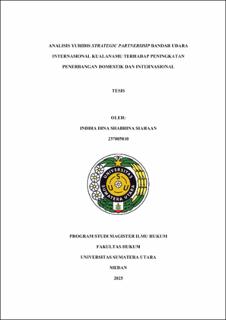| dc.description.abstract | PT Angkasa Pura II, established in 1984, manages airports in western
Indonesia, including Soekarno-Hatta and Halim Perdanakusuma Airports. The
company aims to enhance service quality and competitiveness through more
efficient airport management. However, in 2019, PT Angkasa Pura Il faced
financial pressure due to the Covid-19 pandemic, leading to a decline in passenger
traffic and difficulties in repaying loans. To address this, the company underwent
financial and operational restructuring. As the aviation industry recovered post-
pandemic, PT Angkasa Pura II also expanded through strategic partnerships,
including collaborations with GMR Airports and other partners to manage airports
such as Kualanamu and Hang Nadim. Additionally, the Indonesian government
planned a spin-off for several major airports to improve financial and operational
efficiency. This study employs a normative legal research method, supported by
empirical data through field research, analyzing the applicable legal provisions
and their real-world implications.
The research was conducted directly at the site of the juridical analysis of
the strategic partnership at Kualanamu International Airport concerning the
growth of domestic and international flights. Based on Law No. 25 of 2007 on
Investment, the strategic partnership at Kualanamu International Airport complies
with existing legal regulations and ensures legal certainty, as foreign investment
under this law must take the form of a limited liability company domiciled in the
Republic of Indonesia, with PT Angkasa Pura II retaining a 51% ownership share.
From the results found that the strategic partnership carried out by PT
Angkasa Pura II with GMR Airports resulted in several additional domestic and
international flight routes, where the addition of domestic routes consisted of direct
domestic flights from Medan to Banda Aceh, Medan to Denpasar, Medan to
Padang. For international flights, it is expected to become a transit hub that can
develop like Hang Nadim International Airport in Singapore. | en_US |


